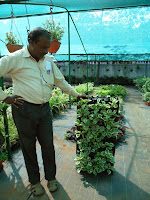 If you have come across
slightly transparent reddish, brown or gray colored and 10-12 cm long worm wriggling
in your gardens, then you have a reason to cheer.
If you have come across
slightly transparent reddish, brown or gray colored and 10-12 cm long worm wriggling
in your gardens, then you have a reason to cheer. The worm is called earthworm and its presence in your garden soil indicates that the soil is nutrient rich.
Nature’s plow as
popularly called, loosen up soil and make it more porous and aerated. They feed
on the soil and organic matter like dried leaves present in it and convert them
into a nutrient rich dark granular castings called as ‘worm castings’. These
worm castings are good fertilizer providing plants nutrients otherwise
unavailable to the plant.
Earthworm’s body is
made of around 100 small segments which are clearly visible on its body. The
first segment at anterior side is its mouth. As it moves, it consume soil thus
making a network on interconnected burrows all the way. These burrows help in passing water and air through
the soil thus helping roots grow. After feeding soil, it will digest the soil
in body. During digestion in earthworm’s body, organic matter present in the
soil is broken down into useful nutrients and excreted as worm castings. That’s
why these worm castings act as fertilizer.
Life cycle of an earthworm
Earthworm lays eggs in
spring in a cocoon buried beneath the soil. Eggs hatch within 3-4 weeks and they
mature within 10 weeks after hatching and a dark 3-4 segment long dark cuticle
appears on the earthworm body. It is called as clitellum. Presence of clitellum
on earthworm’s body is an indicator of sexual maturity. Then it mates and
produces eggs. Disappearance of clitellum indicates onset of old age and
senescence. Earthworm generally lives to 4-8 years.
Attracting earthworm in your garden
Adding nutrient rich
compost to the soil invites earthworm as they thrive in there. Keep your soil
moist and damp. In such conditions, the earthworm’s skin stays wet and moist allowing
it to breathe. Due to the same reason you must have noticed these worms
crawling on the surface after hard rain. Leaf litter around the surface and a
layer of mulch is assumed as an invitation by earthworms. You can bury kitchen
waste in the garden soil to attract more earthworms.
Avoid pesticides and
other chemical sprays as they will repel earthworms.
Vermiculture Composting
It is a process of
decomposing organic matter (waste food, kitchen scraps etc) into a nutrient
rich matter which can be used by plants for their growth using worms like
earthworms.
Earthworm are fed food
waste like fruit and vegetable trimmings, ground egg shells, lettuce leaves and
garden clippings like grass clippings, leaves. You shouldn’t be feeding any
dairy products and meat to earthworms.
Red earthworm ( Eisenia fetida) is best for vermiculture
composting. They are generally found near on the soil surface. Put these worms
with food (mentioned above) in a closed container and let the process going on.
Harvest the earthworms once the food is converted to earthly smelling matter
and granular dark castings are formed.
Know more about your garden soil.
Know more about your garden soil.









